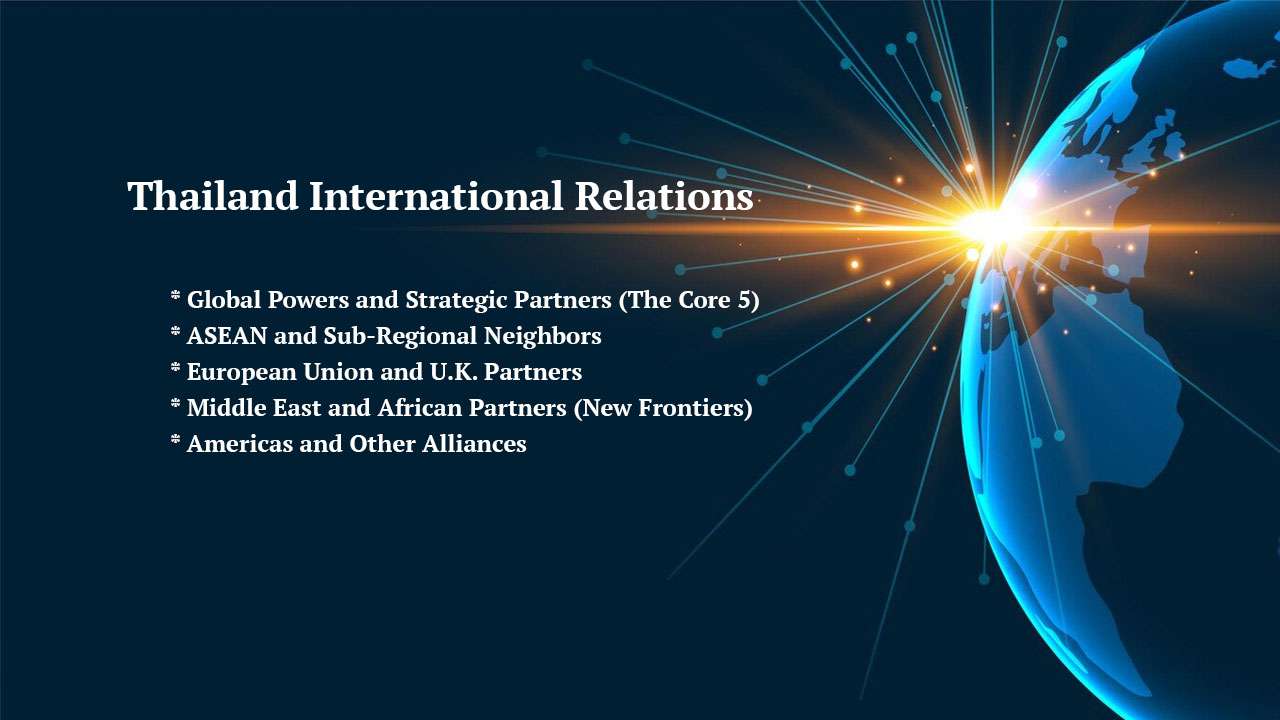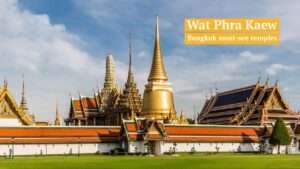
Introduction: Thailand’s Proactive Neutrality
Thailand International Relations are rooted in the principle of “flexible neutrality.” This diplomacy aims to secure national interests and maintain independence. Thailand has consistently established strong ties. This includes nations with embassies in Bangkok. This reflects their high significance in political, economic, and security fields.
The Four Core Dimensions of Thailand Bilateral Relations
- Political/Security: Includes joint military drills and mutual support at global forums.
- Economic/Trade: Focuses on trade value, Foreign Direct Investment (FDI), and FTAs.
- Social/Cultural: Covers educational exchange, tourism, and visa agreements.
- Regional Cooperation: Involves Thailand’s role in ASEAN, APEC, and the UN.
Global Powers and Strategic Partners (The Core 5)
These nations profoundly influence Thailand’s prosperity and stability. They form the foundation of current security arrangements.
| No. | Country | Highlight of the Relationship | Current Challenges |
| 1 | P.R. China | Thailand’s No. 1 Trade Partner and infrastructure investment. The relationship is often called “Pee Nong” (siblings). | Debt concerns from large-scale projects and Mekong water management. |
| 2 | U.S.A. | Long-time Treaty Ally through the Treaty of Amity. Hosts the region’s largest military exercise, Cobra Gold. | Balancing the relationship between China and the U.S. and resolving trade disputes. |
| 3 | Japan | Largest Foreign Investor in Thai industries like automotive. The Japan Thailand Economic Partnership Agreement (JTEPA) is crucial. | Japanese investors are shifting production bases to other nations. |
| 4 | South Korea | Investment in technology and significant Soft Power cultural exchange. FTA negotiation is highly anticipated. | Market and cultural competition within the Southeast Asian region. |
| 5 | India | Shared religious and cultural roots, aligning with India’s Act East Policy. Important cooperation within the BIMSTEC framework. | Addressing the current imbalance in bilateral trade expansion. |
The core mission is to manage Thailand Relations with Major Countries effectively.
ASEAN and Sub-Regional Neighbors
Relations here are paramount due to shared borders and economic grouping (AEC).
| No. | Country | Strategic Importance | Key Cooperation Issues |
| 6 | Malaysia | Largest border trade and security issues in the Southern region. | Resolving armed group concerns and facilitating cross-border trade. |
| 7 | Singapore | A major financial and technology Hub. Key partnership for technology exchange. | Cooperation in the Digital Economy and human resource development. |
| 8 | Vietnam | A significant rival and partner in the AEC. Displays high economic growth potential. | Competition for FDI and enhancing transportation route links. |
| 9 | Myanmar | Long shared border, complex refugee issues, and migrant labor. | Supporting Myanmar’s political stability and border trade security. |
| 10 | Cambodia | Essential land connectivity and occasional border disagreements. | Joint development of border areas and legal labor management. |
| 11 | Indonesia | A leading ASEAN country, a massive market, and maritime security cooperation. | Supporting a strong ASEAN Outlook on the Indo-Pacific (AOIP). |
| 12 | Laos | Crucial rail connectivity and cross-border energy trade (electricity). | Facilitating transit trade and the Laos-China-Thailand rail project. |
European Union and U.K. Partners
This group is a vital source of investment, tourism, and high-tech trade for Thailand.
| No. | Country | Relationship Focus | Key Issues |
| 13 | Germany | No. 1 EU Trade Partner and investment in advanced industries. | Resuming Thailand-EU FTA talks and upholding production standards. |
| 14 | France | Cooperation in education, culture, and defense industries. | Cultural exchange and finalizing defense procurement agreements. |
| 15 | United Kingdom | Investment in education and service sectors with historic ties. | Educational scholarships and expanding service sector trade. |
| 16 | Russia | Key source of tourism, energy, and military equipment. | Managing the economic impact of global sanctions on the Thai economy. |
| 17 | Australia | Strong security ties, education, and agricultural trade (TAFTA). | Counter-terrorism cooperation and educational programs. |
| 18 | New Zealand | Close partnership in agriculture and resource management. | Exchanging agricultural technology and sustainable practices. |
The execution of Thailand Diplomacy Strategy must be agile and pragmatic.
Middle East and African Partners (New Frontiers)
This group is vital for energy security, labor, and accessing large Muslim markets.
| No. | Country | Thailand’s Interests | Cooperation Opportunities |
| 19 | Saudi Arabia | Full restoration of ties, energy source, and massive labor market. | Exporting Thai agricultural products and boosting tourism. |
| 20 | U.A.E. | A key trade and transport center in the Middle East region. | Collaboration in Logistics Hubs, Smart Cities, and Fintech. |
| 21 | South Africa | Gateway to the African market and maritime cooperation. | Trading commodities and facilitating cross-continental investment. |
Americas and Other Alliances
Expanding cooperation helps diversify risks from over-reliance on a single economy.
| No. | Country | Relationship Dimension | Area of Engagement |
| 22 | Canada | Education, investment, and environmental cooperation are priorities. | Expanding collaboration on clean technology and sustainability. |
| 23 | Mexico | Trade expansion and accessing the dynamic Latin American market. | Discussing a bilateral trade agreement for new market entry. |
| 24 | Brazil | Important partner for agriculture, commodities, and the BRICS group. | Cooperation in bio-energy technology and food security. |
Full List of 30 Countries with Embassies in Thailand
The remaining six countries solidify the diverse network of Thailand International Relations:
| No. | Country | Region | Brief Importance |
| 25 | Italy | Europe | Trade in high-end fashion, design, and cultural cooperation. |
| 26 | Philippines | ASEAN | A founding ASEAN member, focused on disaster management and labor. |
| 27 | Sweden | Europe | Investment in telecom and automotive sectors, focused on innovation. |
| 28 | Turkey | M. East/Europe | Intercontinental link, tourism, and industry cooperation (OIC framework). |
| 29 | Chile | South America | Copper mining cooperation and trade within the APEC framework. |
| 30 | Egypt | Africa/M. East | Source of ancient civilization, Islamic education, and aviation hub. |
Conclusion and Future Direction: The Era of Thailand Diplomacy 5.0
Thailand International Relations are now entering the era of Thailand Diplomacy 5.0. This new phase prioritizes digital technology and sustainability. It also addresses crucial transnational threats like pandemics and cybercrime. The core focus will remain on the Balancing Act strategy. Thailand will utilize its potential as a “Bridge” in the Indo-Pacific region.
Want more stories like this? Follow us on X @thaiimpact for daily updates!






